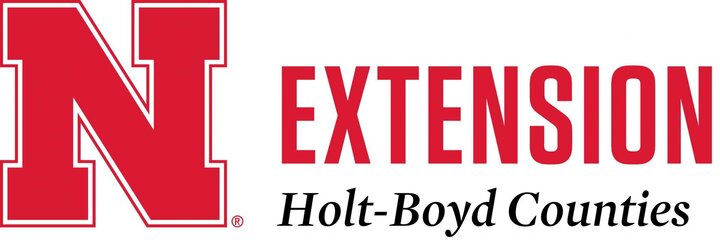
Nebraska Extension Educator - Holt & Boyd Counties - LaDonna Werth
Nebraska Extension Educator - Holt & Boyd Counties - Amy Timmerman
Nebraska Extension Educator - Holt, Boyd, Garfield, Loup, & Wheeler Counties - Bethany Johnston
Nebraska Extension Educator - Brown, Rock, & Keya Paha Counties - Brittany Spieker
Nebraska 4-H Assistant - Holt & Boyd Counties - Debra Walnofer
September 22: ServSafe Manager Certification Program, 8:30am-6:30pm, Brown County Courthouse Basement Meeting Room, 148 West 4th St, Ainsworth, NE - https://extension.unl.edu/statewide/bkr/food-nutrition-health/servsafe-workshops
October 1: ServSafe Manager Training, 8:30am-6:00pm, Hall County Extension Office, Grand Island, NE - https://events.unl.edu/hall-county/2025/10/01/190088/
October 1: Knowing, Growing, and Grazing Grass Registration Deadline, Register at: go.unl.edu/knowing_grass
October 4: Nebraska 4-H Shooting Sports Instructor Initial Workshop, 8:00am – 6:00pm, Panhandle Research Extension Center, Scottsbluff, NE - https://events.unl.edu/NE4H-Shooting-Sports/2025/10/04/189870/
October 4: Nebraska 4-H Shooting Sports Instructor Update Workshop, 9:00am – 12:00pm, Panhandle Research Extension Center, Scottsbluff, NE - https://events.unl.edu/NE4H-Shooting-Sports/2025/10/04/189872/
October 5: Nebraska 4-H Shooting Sports Instructor Initial Workshop, 8:00am – 12:00pm, Panhandle Research Extension Center, Scottsbluff, NE - https://events.unl.edu/NE4H-Shooting-Sports/2025/10/05/189871/
Oct 11-12: Nebraska 4-H Shooting Sports Instructor Update, 9:00am – 12:00pm, Ashland Gun Club, Ashland, NE - https://events.unl.edu/NE4H-Shooting-Sports/2025/10/11/188974/
Oct 11-12: Nebraska 4-H Shooting Sports Instructor Training, 8am – 6pm, Ashland Gun Club, Ashland, NE - https://events.unl.edu/NE4H-Shooting-Sports/2025/10/11/188969/
Oct. 13-30: Knowing, Growing, and Grazing Grass Webinar Series, Monday and Thursday evenings, 7:30pm – 8:45pm CT, go.unl.edu/knowing_grass
October 26: Holt County Achievement Ceremony, 5:00pm, Faith Wesleyan Center, Atkinson, NE
Routines Matter
Why Are Routines Important?
One of the most important concepts for parents and child care providers to consider is the child’s daily routine. A well-thought-out routine can be the secret to a calm, child centered learning environment if planned appropriately. Children desire to know what is coming next in their lives.
If the established routine is consistent and predictable, the children in your care will begin to infer and make sense of “time” related to the events in the daily schedule. Perhaps morning snacks always come after story time, or Johnny’s Dad always arrives shortly after outdoor play. When a caregiver commits to establishing a consistent routine, they are building a sense of trust and children have a sense of control over the day.
On the other hand, if the daily routine is full of unknowns and interruptions, this chaotic environment will likely result in worry and anxiety in young children. Children who cannot yet communicate feelings around the disorganization may instead display disruptive behaviors toward the parent or caregiver and other children in the setting.
Routines In the Home
Parents and caregivers can work together to establish routines at home that are similar to child care and vise-versa. We all lead busy lives,
LaDonna Werth
Extension Educator
Phone: 402-336-2760
E-mail: lwerth2@unl.edu

and weekends and evenings can be even more spontaneous. Parents will find that they have less struggles with their little ones if they can at least keep meals and bed time or nap time close to a normal routine. Don’t forget to communicate together about changes in your normal routine as well. Caregivers who are aware of this can be more sensitive to individual children’s needs.
Example On How To Keep Routine In The Home
Parents can make a simple flow chart of events as a visual for children at home similar to what you might find in a preschool classroom. This could be posted on the refrigerator and as the day goes on, the child could move a refrigerator magnet to the picture of what happens next.
Eventually children won’t rely on moving the marker with each event and will be satisfied with knowing that they have passed a few steps and can visually see what is next. These picture schedules are also great at preparing children for a change in the daily routine. Parents and caregivers can talk about how the routine will be different today with a simple explanation and perhaps rearrange the photos if needed to help the child see how they will go about the day.
Check out these additional tips on establishing routines from extension.
Routine With Infants
For caregivers of infants and toddlers routines Infant getting a bath are all about meeting the needs of the child in a responsive, nurturing way. We wouldn’t expect all infants to be fed, or nap at the same time, but the manner in which you respond and the environment you design to meet the infant’s needs can be seen as your established routine. For more information on establishing routines check out this article from NAEYC.
Key Points When Setting Up Your Daily Routine
- Consider the age and developmental stage of the children when establishing routines.
- Consistency is important to build trust and reduce behaviors and anxiety.
- Parents and caregivers can work together to enhance the consistent and predictable routine.
- If there must be a change in the routine, try to prepare the child ahead of time.
- An established routine will allow you to be flexible when needed with minimal disruptions.
Source: Lynn Devries – Extension Educator (The Learning Child Blog – July 5, 2016)
Harvest 2025 Prep Guide: Minimize Losses in Disease-Stressed Corn
Key Takeaways
- Watch moisture: Stress can trigger premature black layer and faster drydown - check often, especially for silage and high-moisture corn.
- Check stalk strength: Use push or pinch tests; if many fail, move those fields up in the harvest order.
- Manage lodged/hail-hit fields: Harvest a bit wetter and run slow, single-direction passes against the lean.
- Protect kernel quality: Smaller or brittle kernels crack easier - tune header and separator settings to cut losses.
- Handle problem grain smartly: Don’t blend ear-rot or moldy grain - dry to ~14% and cool quickly; use or market it first.
- Safety first: Air can be “dusty” with spores - wear a respirator, check equipment air filters, keep extinguishers handy.
Unusual growing conditions and increased disease pressure in 2025 could have longer lasting and unexpected impacts for harvest and other activities. This list is intended to raise awareness about potential related complications that may occur in your fields and how you can monitor, prepare and minimize losses during and approaching harvest.
Amy Timmerman
Extension Educator
Phone: 402-336-2760
E-mail: atimmerman2@unl.edu

Rapid Senescence and Drydown
Upon reaching physiological maturity (black layer), most corn hybrids are around 30% moisture. The average corn drydown for hybrids reaching maturity in late August is around 0.8 percentage point per day and 0.4 percentage point per day for hybrids reaching maturity in mid-September. High heat and wind, such as we experienced in September 2024, can lead to well over 1.0 percentage point per day in dry down.
Corn diseases - such as southern rust, tar spot and others that have been more common this year - combined with hail damage and lodging due to storms can accelerate senescence and drying of corn. Hybrids have varied in how they handled these pressures. Sometimes these pressures lead to premature death of plants, including the premature formation of black layer. When that happens, grain drying occurred earlier than anticipated with a higher drydown rate per day than if the grain had matured normally.
- Key Point: Monitor the moisture content of grain in fields with heavy disease pressure and/or storm damage NOW. This is especially important if you plan to chop corn for silage or high moisture corn for feed to avoid missing target moisture stages for harvest.
Weaker Cornstalks
Crop stress during 2025, especially diseases and less favorable growing conditions, have led to development of stalk rot diseases and generally weak stalks in many fields. You can determine the risk for corn lodging in each of your fields with the “push or pinch” tests.
- Push test: Push at least 100 corn plants to arm’s length about 30 degrees from vertical. If plants bend below the ear and don’t snap back upright, they have a greater chance of lodging at or prior to harvest if there’s high wind events or heavy rain. When more than 10% of plants fail the test, you should consider harvesting early or harvesting the highest risk fields earlier in your harvest order.
- Pinch test: Squeeze the lower internodes to assess stalk strength and check for stalks that are easily crushed by hand.
Storms and Hail Damage
Furthermore, hail damage and storms that caused severe lodging in some parts of the state (during mid-August 2025) have shortened the grain filling period. Hail damage and lodging in corn causes reduced photosynthesis, vascular disruption, hormonal stress and increased disease pressure. The crop therefore has “matured” faster, necessitating early harvest to minimize further yield loss.
- Hail strips plant leaves, reducing the photosynthetic area. This causes the plant to remobilize stored carbohydrates from stalks and leaves to the ear, accelerating development and dry down, which reduces time to physiological maturity. Hail can also cause stalk bruising and wounding, which weaken stalk tissues and predispose it to stalk rots and lodging. The wounds on the corn ear (tips) can provide entry points for fungal pathogens (e.g., Fusarium, Diplodia) that further affects grain quality.
- Corn may be lodged, leaning and/or broken from storm damage as well. Lodged/leaning plants will still fill the ears but may result in lighter kernel weights and lower test weights. Aim to start harvesting these fields at a higher moisture (above 17%) - and harvest these fields first, as they will be slow. For entire fields that are lodged, growers found harvesting one way against the lodged plants allowed the greatest success of picking up the plants without ears snapping off and/or plugging the combine. Iowa State University offers additional tips on harvesting lodged corn.
Smaller Kernels and Grain Quality Concerns
Loss of leaf area due to diseases, hail, etc. reduces plant photosynthesis and impacts kernel development. These effects can reduce yield but also reduce kernel size and test weight. Kernel damage caused by insect feeding, hail, wet conditions and micro-climate caused by lodged plants may also lead to development of ear rot and grain mold diseases.
- Impacted kernels may be smaller and/or more brittle and prone to breaking during harvest and handling. Adjust combine settings to reduce losses during harvest if your corn kernels (or cobs) are smaller or brittle. Also, aim to harvest grain at a higher moisture (over 17%) to reduce kernel loss.
- Grain that has reduced quality or ear rot diseases should not be mixed in storage with higher quality grain, as fungi usually continue to grow in storage. To help reduce fungal growth in storage, grain should be dried to 14% and cooled as soon as possible. Grain affected by ear rot diseases and mold are less suitable for storage. Use or sell affected grain first and store the highest quality corn possible.
‘Dusty’ Conditions May Reduce Air Quality
Increased corn disease pressure caused by fungi can lead to large amounts of fungal spores circulating in the air over corn fields, especially during harvest. Fungal spores may behave like dust or other particulate matter and aggravate respiratory illness or symptoms in sensitive individuals.
- Consider wearing dust masks or respirators when working in affected fields or around grain, such as in grain bins.
- It may also be important to repeatedly check air filters on equipment operating in conditions with a lot of dust and spores.
Safety
With these challenges in mind as combines start rolling, we hope everyone has a safe harvest season. Be sure to keep fire extinguishers close at hand. Take breaks as needed - especially producers harvesting downed corn, as it will be challenging, tedious work - and care for your mental, emotional and physical well-being.
- The Nebraska Rural Response Hotline is 800-464-0258 and is available for emotional support, legal and financial assistance, and disaster relief.
- If illness, injury or disaster hits, Farm Rescue volunteer crews and equipment can help farm families in crisis finish harvest. Learn more about their services and apply online.
- Fire safety tips for harvest are available on CropWatch.
Source: Tamra Jackson-Ziems - Extension Plant Pathologist, Jenny Brhel - Extension Educator, David S. Wangila - Extension Educator (CropWatch – September 19, 2025)
Reviewing Cow-Calf Share and Cash Lease Agreements
The trend in cattle prices over the last year across all classes of cattle has been strongly higher. These changes in market values and projected adjustments of interest rates are having an impact on beef cow share and cash lease agreements in determining what is “fair” to both cow owners and those who are leasing the cows.
For a cow owner, the following are the four major drivers that determine what is "fair" in terms of a cash lease or percentage of the calf crop the cow owner should receive. Those factors are:
- Average cow herd value
- Cow value leaving the herd or weigh-up price
- Replacement rate
- Expected rate of return (interest rate) on cow value
The average market value of weigh-up cows and bred cows is exceptionally strong. Many of the states that are leading in beef cow numbers are no longer in drought and have ample supplies of forage. Hay and grain prices will in most places be equal to or lower
Bethany Johnston
Extension Educator
Phone: 402-336-2760
E-mail: bjohnston3@unl.edu

this fall than they were last year. These changes in market value are impacting what is “fair” in terms of the amount of cash lease that would be expected to go to cow owners, or the percentage of the calf crop a cow owner should receive. This change is due to the current market value of a bred cow versus what bred cow and weigh-up cow values were the last several years. The significant recent increase in cow value means the person owning the cows may need to receive a larger cash lease payment or percentage of the calf crop to reflect more accurately what is “fair” when compared to market conditions just a few years ago. The projected moderating interest rates will also impact what is a “fair” share and cash lease rate as well.
For the upcoming 2026-year, cow-calf share leases or cash leases should be reviewed. The lease should accurately reflect the value of what each person will contribute to the production of weaned calves and what their compensation should be either in cash or in a percentage of the calf crop.
The Center for Ag Profitability hosted a webinar in the fall of 2024 titled “What is Fair in Cow Leasing: Cash vs. Shares” which highlights the differences between these lease agreements. The webinar also presents information on key things that cow owners and operators need to discuss before entering into or when reviewing an agreement. The UNL Beef website has additional resources that can help both cow owners and those leasing cows in determining what a “fair” lease arrangement should be. Two resources are: the Beef Cow Share Lease Agreements Extension Circular 841, and a video explaining the use of the Cow-Calf Share Lease Cow-Q-Lator, an Excel® based spreadsheet.
Annually reviewing cow-calf share or cash cow lease agreements is prudent under fluctuating market conditions. For cow share or lease agreements to be successful long term, it must be equitable for all parties involved.
Source: Aaron Breger – Nebraska Extension Educator (September 18, 2025)